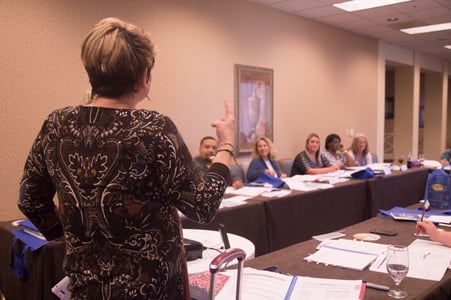
It happens every time. You introduce a new dimension and think you’ve done a great job of explaining the definition of the dimension, the indicators and the types of interactions an observer may see. You’ve had your participants identify key words in the dimension definition as a way to solidify their understanding. Now it’s the moment of truth. You play the first exemplar. Things are looking good. Participants are looking at the face page and sharing their observations. You validate and expand on their comments, “That’s right. The teacher was sitting on the floor playing with the children. That’s a nice example of close physical proximity, one of the things we look for as evidence of relationships in Positive Climate.”
You’re feeling pretty good and are silently congratulating yourself on doing a terrific job of explaining the material. Then it happens, that comment from left field. OK, it’s not really from left field, but it’s not accurate. What do you do? You can’t really tell someone that they are wrong, can you?
The answer is a resounding “Yes.” Participants need to know if their observations aren’t correct. Accurate use of the CLASS tool requires that observers know where different interactions fit – both in terms of dimensions and indicators. Letting an erroneous observation slide may lead your participants to have an inaccurate understanding of how to code with the CLASS tool. Just nodding your head to all the participant responses, or agreeing with anything they say is affirming but too often inaccurate. Instead of thinking of your next question, stay in the moment and listen to what they are saying very closely. Then SORT their comments into the right dimension and indicator.
Instead of flat out telling someone that they are wrong, try these comments instead:
- “I observed that as well. It’s a better example of _____________.”(Name the indicator and/or dimension as appropriate.)
- In the early part of the training, you may say, “Yes. That definitely happened, but it fits in a dimension that we haven’t talked about yet. When we do, I’ll be sure to point out why that interaction fits there.” (And then really do!)
- Later in the training, you can ask the participants to look at the manual face page to see where it fits or you can ask others where the observation belongs.
- You can also buy yourself some time trying to think which dimension it goes under, honor the participant’s comment, AND model getting into the manual by saying, “That’s a great observation, let’s everyone thumb through the face pages in the manual and find where that goes…”
- Or you can say, “You really have a sharp eye for detail, that’s an accurate observation in that it’s evidence in the CLASS tool, but not in that dimension. Can you take a guess at where it might land?”
In sum, to be effective, CLASS trainers have to tell participants when their observations are wrong. How we tell them makes the difference. Validating observations and guiding participants to the correct dimension and indicator helps them increase their understanding of the tool. In the parallel process of embodying the CLASS tool ourselves as trainers, we need to create a Positive Climate by carefully affirming their answers, be a Sensitive trainer and encourage them to take risks by verbalizing their ideas, and encourage Concept Development (analysis and reasoning and classification) by getting them to help them sort their answers into the right dimensions and indictors in the manual.
Special thanks to staff trainer, Curry Ander, for her help with this blog post.
